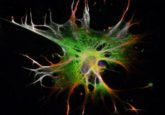The science of chewing

Chewing is usually a thoughtless act, but it is actually quite complicated. It requires cells to eavesdrop on their neighbors in order to coordinate the speed and pattern of the jaw, teeth, tongue.

Not much thought is given about the act of chewing, but it actually involves a lot of processing. It is a rhythmic activity that is essential to life.
Chewing is one of those bodily functions that just seems to happen. It doesn’t require much conscious thinking, but it certainly requires brain power. “If you’re chewing on a carrot or a peanut that has a different consistency than chewing gum or something softer, then your mouth needs to know where the food is, where it’s positioned, and how hard it is, to predict how much pressure to apply,” said Arlette Kolta from the University of Montreal, who investigates cellular circuits and mechanisms involved with chewing, and published a study in Nature Neuroscience describing the neuronal signaling processes that coordinate it.
Sensory neurons weave their way throughout the oral cavity, including around the roots of teeth. When a person is chewing, these neurons send messages to the brain about the consistency of food, how much force is being generated, the size of the food, and even how much the jaw needs to open. These signals are picked up by neurons, which generate rhythmic behaviors such as chewing, breathing, and walking. These neurons generate a rhythmic pattern of electrical activity using a sodium channel that is sensitive to extracellular calcium concentrations.
Kolta’s team found that astrocytes, an abundant but often overlooked glial cell type in the brain, sit between sensory neurons and rhythmic neurons and eavesdrop on their conversation. “And when they hear that these sensory neurons have something interesting to say, then they release a protein called S100B that decreases extracellular calcium,” said Kolta. Sodium channels of rhythmic neurons detect this decrease and adjust their pattern of rhythmic firing activity accordingly.
The researchers next inactivated astrocytes, causing the rhythmic firing of neurons to stop. When they restored rhythmic firing by adding S100B, they confirmed that astrocytes regulate chewing by controlling neuronal rhythmic firing via the S100B protein. There are various subpopulations of rhythmic neurons, each responsible for controlling a particular oral muscle group. So, when rhythmic neurons respond to extracellular calcium changes controlled by S100B, they not only change the speed of chewing, but also the pattern of movement itself.
The speed and the pattern of chewing is important to ensure that food can be swallowed. According to Callum Ross of the University of Chicago who investigates chewing and swallowing but was not involved in this study, a lot of the sensory information collected by sensory neurons in the mouth travels to the cortex. “The cortex is very busy. It’s paying attention to how that chewing is happening. The brain has to predict if this piece of food is going to go over my trachea and down into my esophagus safely. That’s the key thing,” said Ross.
This research is important not only for chewing, but for understanding how the brain processes other rhythmic behaviors, which may be more difficult to measure. “You cannot live without chewing, that’s for sure,” said Kolta. “Rhythmic movements are considered vital movements, and we think that’s why they are ensured by very robust mechanisms.”
Research on rhythmic behaviors, such as chewing, may also shed light on some pathological conditions, such as epilepsy or Parkinson’s disease, where circuits that should not work rhythmically become rhythmic. “It’s exciting to me because chewing and swallowing are an important part of everybody’s daily life,” said Ross. “There’s a large number of people with chewing and swallowing disorders, and it’s very understudied and it’s an area where a lot of research is needed.”
So during Thanksgiving, remember that within every chew there is a lot of brain processing. And give thanks for the complicated rhythmic neuronal firing that makes chewing “brainless.”



